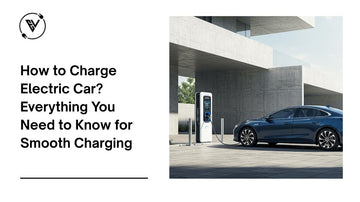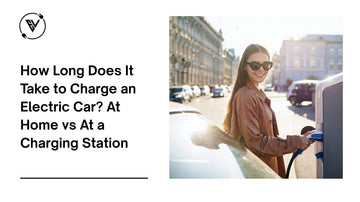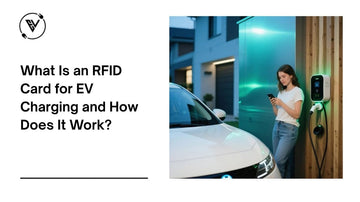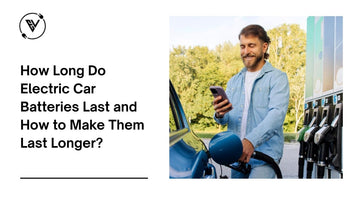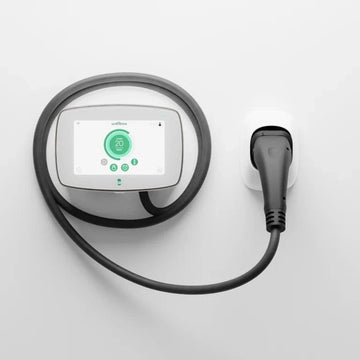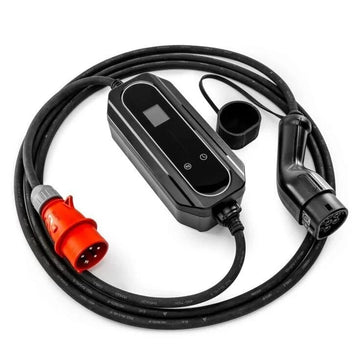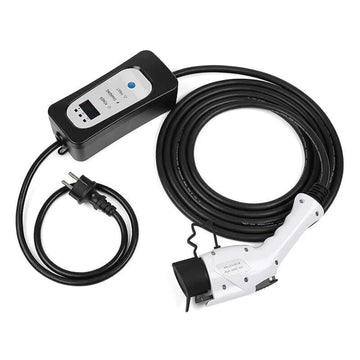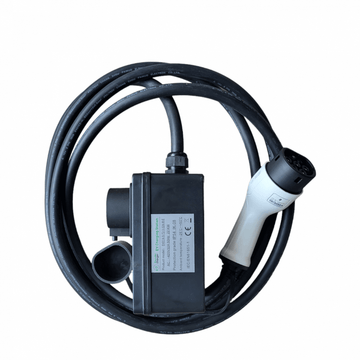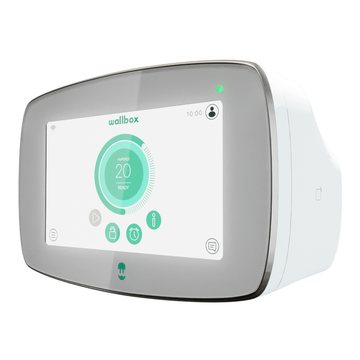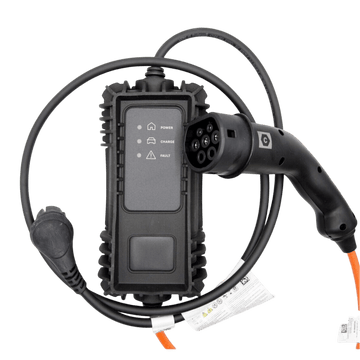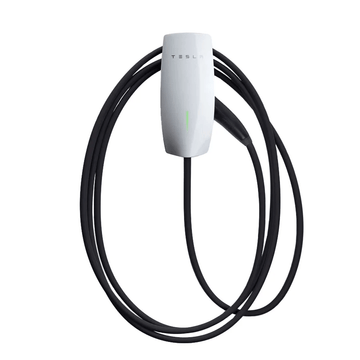Charging an electric car means putting energy into the car’s battery so it can move. Instead of filling it with petrol or diesel like a normal car, you plug it into a charger that puts power into the battery. This is called electric vehicle charging and it’s something every EV owner needs to know.
To charge an electric car you plug it into a power source using a special cable and connector. You can charge at home, at work or at public charging points. Depending on the charger it can take 30 minutes to several hours. You’ll usually use an app, RFID card or contactless card to start the charge. Different electric cars have different connectors so knowing what type your car has is important. Home charging is the most convenient but public EV chargers are useful for longer trips or when you’re out and about.
How Do I Physically Charge the Car?
To charge an electric car, you need to plug a charging cable into the car’s charging port. Most electric cars have a flap where the charging port is hidden, kind of like where petrol or diesel cars have a fuel cap.
Plugging In
First, park your EV near the charger and turn off the car. Open the charging flap and plug the connector into the car. Some chargers are tethered, meaning the cable is already attached. Others are untethered, and you’ll need to use your own charging cable.
Connectors and the ‘Handshake’
Once the cable is plugged in, the car and charger do a quick safety check, which is called a “handshake.” They make sure the power is safe to flow. After this, charging starts automatically or through an app or card.
You might ask, “how to charge an electric car at a charging station?” It’s mostly the same process. Plug in, start the session using the app or card, and wait until it’s charged.
Where Can I Charge My EV?
You can charge your electric car in these places:
Home Charging
Charging an electric car at home is the easiest way to keep your car ready to drive as it only takes a dedicated home ev charger. If you have off-street parking like a driveway or garage, you can get a dedicated home EV charger installed on the wall. This lets you plug in overnight so your battery is full by morning.
Most home chargers are 7kW and can add about 10 to 30 miles of driving range for every hour your car is plugged in. If you want even faster charging, you can get a 22kW home charger, but your house needs to have the right kind of power for that.
Home chargers are built with safety features, and some come with Wi-Fi so you can track your energy use or get updates. Most of the time, the charger has a cable already attached, but some use a separate Type 2 charging cable that you plug in yourself. If your car didnt come with one, or you want a spare - order it when you buy your charger.
To learn more, here’s how to install an EV charger and check the EV charger installation cost.
At Work
Some workplaces have chargers in their car parks. This helps you top off your vehicle’s battery while you work.
Public Charging Stations
You can find public electric vehicle chargers in places like supermarket car parks, motorway service stations, shopping centres, and city streets.
Long Trip Charging
When going on long journeys, rapid chargers and ultra-rapid chargers at motorway service stations are very useful. They charge your electric car quickly, so you’re back on the road fast.

How to Find Electric Car Charging Stations?
There are lots of ways to find charging stations. Most EV drivers use EV charging apps. These apps show where public charging points are, what type of charger is available (AC or DC), and if the charger is free or in use.
Some EVs have built in navigation that shows electric car charging points along your route. You can also use Google Maps and filter by “EV charging.”
How Long Does Charging Take?

Charging times vary based on the charger speed and your car's battery. There are three main types of charging:
- Slow Charging (AC): Used at home for overnight charging. Power from a regular socket or a slower home charger.
- Fast Charging (AC): Used at home or work. It can charge the car’s battery in a few hours.
- Rapid Charging (DC): Found at public rapid charger stations. These can charge an EV to 80% in about 30–60 minutes. Ultra rapid charging is even faster.
What Affects How Long My Rapid Charge Is Taking?
Sometimes charging speeds of your electric car take longer than expected and here’s why that happens.
Battery Charge Level
If your car’s battery is really low, it charges fast at first but then slows down a lot when it gets close to full to protect the battery. This is normal and prevents the battery from getting too hot or wearing out
Battery Temperature
If it’s really cold outside, your car’s battery might need some time to warm up before it can charge. Cold batteries charge slower and the car might even use some power to heat up the battery before charging starts.
Charger Sharing and Power Limits
Some chargers are shared with other cars at the same time. If someone else is using the charger too, your car might not get full power so it takes longer.
Vehicle Charging Capabilities
Even if you’re using a super fast charger, your car might only be able to take in a certain amount of power. Some electric cars can take in more power than others so how fast it charges depends on your car too.
Cable Quality and Compatibility
If you use your own cable at an untethered station, make sure it’s a strong, high-quality charging cable that works with your car. Weak or wrong cables can slow down the charging a lot.
How Much Does Charging Cost?

It depends on where you're charging your car, what chargers you're using, and so on but here are the basic guidelines.
Home Charging
Home charging is usually the cheapest, especially if you charge overnight with lower electricity rates. You’ll need a wall charger installed to get the best speeds.
Public Charging
Public EV charging prices vary depending on the provider and charger speed. Some public chargers are free, but public rapid chargers often cost more. You usually pay per kWh or by time.
Electric Vehicle Charging Connectors
There are some types of connectors for electric cars:
- Type 1: Common in older and American EVs.
- Type 2: Common in Europe and new electric cars.
- CHAdeMO: For some Japanese models like Nissan Leaf.
- CCS (Combined Charging System): Supports AC charging and DC charging, popular in Europe.
- Tesla: Has its own plug in some places, but often include a Type 2 or CCS adapter.
Make sure to use the correct one for your vehicle.
EV Chargers: What Cable Do I Need?
What electric car charger you need it depends on your car. Some chargers are tethered, which means the cable is attached. Others are untethered, so you need your own cable.
If you need a new one, check out:
If you switch between cars, a Type 1 to Type 2 adapter or Type 1 to Type 2 charging cables might help.
EV Charging: How Do I Pay or Start a Charge?
You usually start a charging session with:
- A smartphone app
- A contactless credit or debit card
- An RFID card (provided by the charger network)
Even though different charge point operators have different systems, most public EV chargers suport one or more of these.
What’s the Correct Etiquette of Charging Electric Vehicles?

Charging an electric car in public means you, same as other electric car drivers, should follow some polite rules so everyone gets their turn on time.
Don’t Overstay at Charging Points
Once your car is done charging, you should unplug it and move it, so someone else can use the charger. Staying plugged in for too long blocks others who need to charge their cars.
Never Unplug Other Vehicles
It’s not okay to unplug someone else’s car, even if it looks fully charged. Some EVs don’t lock the cable, but it’s still rude and could mess up their charging session.
Only Use Charging Bays When Charging
Don’t park in a charging spot unless you’re actually charging! These spaces are for people who really need power for their cars, not just for parking close to the entrance.
Keep Charging Spaces Clean and Safe
If you’re using your own cable, always put it away neatly after you’re done. Don’t leave it lying across the ground where someone could trip over it.
Be Patient
Sometimes chargers are broken or someone is taking a bit longer to finish. Be kind and patient as everyone’s trying to charge just like you.
Can I Turn On My Electric Car While It’s Charging?
Yes you can turn on your electric car while it’s charging but you can’t drive it or use power steering. Some things in the car like the heater or radio will still work though. This is useful if you want to warm up the car on a cold morning before driving.
Do I Need To Charge My Electric Car Every Night?
You don’t need to charge your electric car every night unless the battery is getting low. Charging a little every day will wear the battery out faster over time. If you don’t drive far and still have plenty of battery left, it’s usually better to wait and charge less often with bigger charges. But if your battery is almost empty, then yes go ahead and charge it.
What Is the Best Way to Charge an Electric Car Battery?
As we're approaching the end of the article, we want to share some tips on best ways to charge your electric car.
Home Charging for Daily Use
Charging your car at home overnight is the easiest way to keep your battery full. You can plug it into a home charger and wake up to a full battery. If your house has special power, you could get a faster 22kW charger to charge even quicker.
Public Charging When Away From Home
If you don’t have a garage or driveway, you can use public chargers at places like work, car parks, or near your house. Use an app to find the closest one.
Planning for Long Journeys
When you go on a road trip, stop at charging stations along highways. These rapid chargers can give you lots of battery in 30 to 60 minutes, which is perfect for a snack break while your car charges.
Using the Right Cable and Charger
Make sure you have the right cable for your car. For Teslas, you can use Tesla charging cables. If your car has a Type 1 plug but most chargers are Type 2, use a type 1 to type 2 adapter or type 1 to type 2 charging cable so it fits properly and works well.
Protecting Battery Health
To keep your battery working great for a long time, try not to always charge it all the way to 100%. Most of the time, stopping around 80% is enough and better for the battery. Also, charging when it’s not too hot or cold outside helps a lot.
Charging electric vehicles might seem tricky at first, but once you know how to charge your electric car, it's just part of the drive.


